Who’s Laughing Now?
Long maligned as nasty scavengers, hyenas turn out to be protective parents and accomplished hunters
Our headlights pick up the gleamıng eyes of nine spotted hyenas stalking single file across the savanna. "Zebra hunt," says Kay Holekamp, killing the Land Cruiser's engine. We're about 100 miles west of Nairobi in Kenya's Masai Mara National Reserve.
The hyenas walk parallel to the herd with their heads turned toward it. The agitated zebras gallop back and forth in short, panicky dashes, then skitter off into the absolute darkness. The hyenas follow at a walk and disappear into the night. "They'll circle, watch, lie down, then get back up and do it all again until they finally decide to attack," says Holekamp, a biologist who has been studying spotted hyenas in the park for 20 years.
Spotted hyenas are some of Africa's most proficient predators. A frenzied scrum of them can dismantle and devour a 400-pound zebra in 25 minutes. An adult spotted hyena can tear off and swallow 30 or 40 pounds of meat per feeding. Latecomers to a kill use their massive jaw muscles and molars to pulverize the bones for minerals and fatty marrow. Hair and hooves get regurgitated later. "The only thing left is a patch of blood on the ground," says Holekamp.
Holekamp, 56, alternates working in the field in Masai Mara and teaching at Michigan State University in Lansing. (She lives on 13 acres outside the city with her partner and occasional collaborator, neurobiologist Laura Smale, also a professor at MSU.) Everyone around Masai Mara knows "Mama Fisi"—fisi is Swahili for hyena—the blond woman in oversized T-shirts who returns every summer to her tent camp on the Talek River, where baboons sometimes raid the food tent, a gennet cat loiters near the supper table, bats hang from tent poles and the night resounds with chuffing leopards, pinging fruit bats and whooping hyenas. "I expected to study spotted hyenas for three years and move on," says Holekamp, "but they just kept getting more interesting."
Though they resemble dogs, the four species of hyena—spotted, striped, brown and the aardwolf—are actually more closely related to cats, and closest to mongooses and civets. Spotted hyenas (Crocuta crocuta), also known as laughing hyenas, live in forests, swamps, deserts and mountains throughout Africa. They are the best-known, biggest (up to 189 pounds, though 135 is typical), most numerous and strangest hyenas, and not just because of their sloping profile and demented "laugh"—a high-pitched cackle they emit when frightened or excited. Spotted hyenas are also gender-benders and role reversers.
Spotted hyenas sometimes scavenge, but, contrary to popular belief, they kill 95 percent of their food. As hunters, alone or in groups, they equal leopards, cheetahs and lions. Yet the lion is considered noble, the cheetah graceful and the leopard courageous, while the hyena is seen as sneaky and vicious—a cringing scavenger, a graveyard lurker. Few creatures inspire such a queasy mixture of fear, disgust and disdain. Most zoos snub them—no public demand. Conservation groups do not use hyena photos to raise money. Across epochs and continents, from the Bible to African folk tales, from Theodore Roosevelt ("foul and evil ferocity...as cowardly as it is savage") and Ernest Hemingway ("devourer of the dead...sad yowler, camp-follower, stinking, foul") to Disney's The Lion King ("slobbery, mangy, stupid vultures"), our reaction to hyenas is the same: yech.
In the 1960s, a few field researchers finally began peeling away centuries of ignorance. The chimpanzee expert Jane Goodall, working in Tanzania's Ngorongoro Crater, expected to dislike spotted hyenas, but they soon won her over. "Hyenas are second only to chimpanzees in fascination," she wrote; "they are born clowns, highly individualistic." Wildlife biologist George Schaller, studying lions on the Serengeti in the 1960s, exploded another misperception by reporting that lions scavenged more kills from hyenas than vice versa. Around the same time, naturalist Hans Kruuk spent three and a half years with the Serengeti's spotted hyenas. He expected odious solitary scavengers but instead found sophisticated hunters living in complex clans. In 1979, Laurence Frank, from the University of California at Berkeley, began studying spotted hyenas in the Masai Mara. A few years later he and his colleague Stephen Glickman captured 20 cubs and took them back to Berkeley for a long-term study. Today 26 captive hyenas live in a research center in the hills above campus.
Holekamp got her doctorate at Berkeley, writing a dissertation on ground squirrels, and then worked briefly with Frank in Masai Mara. Spotted hyenas won her over. In the past 20 years she and her graduate students have created a large database about the Masai Mara animal's diet, movements, communication, births, deaths, lines of descent, morphology, conservation, intelligence, social organization and behavior. But Holekamp is most interested in the ways hyenas bend gender roles. "By studying an animal that seems to contradict the usual rules," she says, "you can shed light on what the rules really are. Plus, I just think they're really cool."
One gender contradiction is the female spotted hyena's long clitoris, almost indistinguishable from a penis, through which the animals urinate, mate and even give birth. Scientists call the unusual organ, which is capable of becoming erect, a pseudopenis or a peniform clitoris. To further confuse matters, a female's labia are fused and made bulbous by two fatty pads, creating the illusion of a scrotum. For centuries, because of these anomalies, hyenas were suspected of being hermaphrodites capable of changing gender and performing witchcraft. More than once, Holekamp has been startled when a putative male known to her since cub-hood suddenly gave birth.
What's more, female spotted hyenas are bigger and more aggressive than males. Every clan is a matriarchy ruled by an alpha female. In the clan's strict power structure, adult males rank last. They must swallow abuse even from the most obnoxious juveniles or risk violent punishment from female coalitions. At a communal carcass, adult males eat last—if there's anything left. When a male kills dinner on his own, he must gorge quickly before female clan members shove him aside.
Nor do things improve much when it comes to mating. "With most animals, males duke it out and the winner gets the girls," says Holekamp. "But with hyenas, females have 100 percent say." They decide when and under what conditions they will tolerate deferential sperm donors. At age 2 or 3 a male leaves his natal clan and wanders off to beg acceptance into another clan. After vicious rejections, he eventually succeeds and reaps his reward: brutal harassment as the clan's nadir, one of the last in line for food and sex. This probation, which biologists call "endurance rivalry," is a test, Holekamp explains: "The guy who can stick it out the longest wins." The trial lasts about two years, after which some females may grant him access. "You do not want to be a male hyena," Holekamp says.
An hour before dawn, we are bouncing along a track in Masai Mara. Topi antelopes stand quietly in the dark, Thomson's gazelles dash away and a giraffe's silhouette brushes the fading stars. Hyenas usually rest during the hot daylight hours, so Holekamp and her researchers typically work a split shift in the field, mornings from 5 to 9, evenings from 4 to 8.
The Land Cruiser's transmitter beeps, indicating a radio-collared hyena nearby. It's Murphy, alpha female of a clan that Holekamp calls Talek West. (Murphy's half-sister, Whoopie, rules Talek East.) Each clan comprises about 50 animals. They had once been united under their mother, Bracket Shoulder, who had been in power for a decade when Holekamp first came to Masai Mara. Thus Bracket Shoulder and her daughters have ruled the Talek group for 30 years.
The clan split into east and west factions in the late 1990s when herders from the Masai tribe began illegally grazing their cows in the middle of the clan's territory. Grazing has worsened as growing numbers of people and livestock press against the reserve, home to 400 to 450 adult spotted hyenas. The Masai, like herders and ranchers throughout Africa, consider hyenas livestock-killing vermin. They often stab, snare or poison them. Nevertheless, spotted hyenas are the most numerous large predator in Africa.
The Masai have largely escaped the violence that has racked Kenya since disputed elections in December. Before a power-sharing agreement was reached in March, more than 1,000 people were killed and 500,000 or more were displaced. In Masai Mara, the upheavals have led to more poaching, fewer tourists and less money for conservation, but the hyenas that Holekamp's group studies haven't been harmed.
"Most hyenas die violently, from lions or people," says Holekamp, "but Bracket Shoulder died at 17 of kidney failure. And she was still in power." She still had perfect teeth, too, since her rank assured her the best cuts of meat, whereas the teeth of lower-ranking animals get chipped and worn from crunching bones.
As sunrise suffuses the sky, we pass through a section of tall grass, the boundary with the neighboring Fig Tree clan. Three hyenas appear in the fresh light, their bellies distended, heads and chests bloody. One carries what's left of the kill, a topi's skullcap, recognizable by its tall ridged horns. Hyenas peel the horns' keratin coating and eat the bones beneath.
Spotted hyenas in Masai Mara subsist mostly on topis and Thomson's gazelles until the great herds of wildebeest migrate through from the Serengeti. Holekamp thinks hyenas' favorite food is fresh zebra—she's seen them bypass easier prey in hopes of a striped entree—but they will eat anything with fur, feathers, wings or scales. Holekamp was once puzzled by a group of hyenas that seemed to be grazing; they were licking a bloom of caterpillars off the grass. After a rain, when termites shoot out of their mounds like fountains, hyenas stand over the holes and guzzle.
To a hyena, almost anything organic is edible. Aimee Cokayne, a research assistant who's been living at Fisi Camp for much of the past 20 months, remembers a hippo that died in a mudhole. Hyenas tore chunks from the rotting carcass for months, unfazed by the increasing putrefaction. Holekamp says that if Masai boys flip a large tortoise onto its back as a prank and it decays into a tureen of carrion soup, hyenas lap it up. (They also roll in it.) They even snack on the dung of wild dogs and wildebeests. Is anything putrid enough to gag a hyena? Holekamp thinks hard. "No," she finally says. "I haven't seen that yet."
She is collaborating with a microbiologist at Michigan State to study hyenas' hardy immune systems. Other species suffer pandemics (rabies in wild dogs, distemper in lions, anthrax in ungulates), but hyenas appear to be unscathed by disease, not to mention rotten meat. "How do they tolerate foods that most creatures find deadly?" Holekamp is still trying to figure that one out.
The center of a spotted hyena clan's social life is the communal den. A pregnant hyena goes off alone to give birth, then moves her cubs to the den when they're a month old. The den is usually adapted from a hole dug by aardvarks or other small animals, and has multiple entrances connected by tunnels dug by the cubs. The earth around the den is quickly worn bare by frolicking cubs and lounging adults. The cubs spend eight months there with the clan's other youngsters—a dozen at a time isn't unusual, and Holekamp once saw a den with 22.
One early evening at the den of the Fig Tree clan, half a dozen hyenas are lying in the grass around the entrance. Holekamp, Cokayne and a graduate student named Sarah Benson-Amram, who's been living at the camp for a year, can recognize more than 100 hyenas from the Talek and Mara River clans, identifying them by their shoulders, ears, faces or sides. But they are just getting to know the Fig Tree group. A cub named Figaro, young enough to still have black fur, emerges from the den and gets licked all over by its mother, Carmencita. Bigger cubs with new spots—they start to lose their black baby fur at six weeks of age—boil out of the den and romp around, pawing and nipping each other. One of them grabs Figaro by the ear and pulls the small cub over. The other three play tug of war with a stick, rehearsal for future battles over a topi's haunch or a gazelle's torso. An older cub nudges a sleeping female named Fluffy, who jerks her head, a warning. The cub jumps back but tries again, shoving its head into Fluffy's belly. "She's managing to introduce herself," says Holekamp.
Hyenas have a complex behavioral language. Casual hellos include nuzzles, muzzle licks and body rubs. More formally, and nervously, a subordinate animal will lift its hind leg to expose its erect penis or pseudopenis for the dominant animal to sniff or lick. Other deferential gestures include giggling, head-bobbing and groveling. Males are the principal appeasers, says Holekamp, "because they stand to lose a lot"—status, access to food and mating—"if their relationship with the girls gets messed up."
As the sun lowers, more hyenas return to the den. An adult named ET puts her head into the entrance. "She's groaning, calling her cubs," says Holekamp. ET backs partway into the den so her cubs can nurse without coming out. "She must have really little ones hiding in there," says Holekamp. Moments later a tiny black head pops up behind ET, then quickly ducks back inside. "Too scary," says Holekamp. "Too many hyenas out here."
A series of high whoops comes from our right, homecoming signals from two cubs who've been on an excursion with five adults and two subadults. One of the new subadults lunges at Fluffy, who bares her teeth. The teenager retreats but returns seconds later with a teenage ally. They stand stiffly over Fluffy, muzzles pointed at her, tails bristling.
"Poor Fluffy," says Holekamp. "She's just lying there, and this teenager picks a fight, then forms a coalition with another kid. Teenagers are insecure about their rank so they're always trying to prove it. Girls are particularly tenacious, because if they lose their rank, it can have lifelong consequences, so they're constantly picking fights."
Cubs enter life with their eyes open and some of their teeth erupted, and within minutes siblings are fighting one another to establish dominance. The mother has only two nipples; in a litter of three, the least aggressive cub will usually starve. Cubs inherit their mother's rank, and the higher it is, the more likely her cubs will reach adulthood and reproduce: status ensures powerful allies, extra protection and a bigger share of the food. The effects of a mother's status can be stark. Holekamp has a photograph of two 6-month-old cubs sitting side by side. One is twice as big as the other—the difference between having a mother ranked No. 1 and No. 19.
A recent study by Holekamp and her colleagues suggests that status begins in the womb. They discovered that in the final weeks of pregnancy, high-ranking females produce a flood of testosterone and related hormones. These chemicals saturate the developing cubs—both males and females—and make them more aggressive. They're born with a drive to dominate, which presumably helps them uphold their matrilineal status. By contrast, a pregnant subordinate female produces a smaller spike of hormones, and her descendants become subservient. Holekamp says this is the first evidence in mammals that traits related to social status can be "inherited" through a mother's hormones rather than genetics.
Perhaps the most perplexing question about hyenas is why females have pseudopenises. The structures complicate mating and birth. The hyena's reproductive canal is twice as long as that in a similarly sized animal, and what's more, there's a hairpin turn halfway to the uterus. "It's a long gantlet for sperm to run," says Holekamp. It's also an ordeal from the other direction. Among the first-time mothers in captivity, according to the Berkeley researchers, 60 percent of cubs die during birth, most from suffocation after getting stuck in the birth canal. Subsequent births are easier.
Surprisingly, the pseudopenis doesn't appear to be a side effect of the hormones a female is exposed to in the womb. In other mammals, testosterone-related hormones can masculinize a female fetus's genitalia. But when the Berkeley researchers fed pregnant hyenas drugs that blocked the effects of testosterone and related hormones, the female cubs were still born with pseudopenises.
The most obvious advantage of "these bizarre structures," as Holekamp calls them, is power over reproduction. Mating is impossible without full female cooperation. And if a female changes her mind about a male after mating, the elongated reproductive tract lets her flush out the sperm by urinating.
Holekamp has developed a new theory to explain the evolution of the hyenas' female-dominated social structure and odd reproductive apparatus. "I think the bone-crushing adaptation is the key to it all." She explains: spotted hyenas' ancestors evolved massive skulls, jaws and teeth so they could pulverize and digest bones. This gave them a tremendous advantage over other predators, but with a cost: the skull and jaws that make bone-crushing possible take several years to mature. Holekamp has found that young hyenas can barely crunch dog biscuits. Hyena mothers care for their cubs for three or four years, much longer than most other predators do. Alone, cubs would be unable to compete for food at kills. "That put pressure on females to give their kids more time at the carcass," says Holekamp. Females had to become bigger and meaner, Holekamp hypothesizes, which they achieved partly by boosting their "masculinized" hormones. If Holekamp is right, female dominance and matriarchy among spotted hyenas stem from evolutionary adaptations made for the sake of feeding the kids.
One dawn we spot a hyena named Cashew. She is 4, old enough to collar, so Cokayne prepares a tranquilizer dart, aims for the haunch and fires. Cashew leaps sideways, bites the dart, spits it out, sniffs it, flinches, sniffs again. Then, seemingly unfazed, she resumes her steady pace and disappears into the tall grass.
Cokayne gets out of the Land Cruiser to look for Cashew as Holekamp drives slowly ahead. A few yards into the tall grass Cokayne finds the animal conked out. Holekamp takes several vials of blood from Cashew's long, muscular neck, then measures the skull, tail and teeth. She is three feet long, 112 pounds, a petite strawberry blonde with coarse fur and tan spots. Her big black nose and feet are doglike. Her dark brown nipples are growing; she might be pregnant for the first time. (For an earlier study, Holekamp and her colleagues used portable ultrasound equipment to determine how many fetuses were carried by female hyenas.) Cokayne scrapes some beige paste from a gland near the anus; hyenas rub this musky substance onto grass, stones and trees to mark their territory. Holekamp has witnessed clan wars near territorial borders. Females lead the attack.
Holekamp and Cokayne fit Cashew with a radio collar and an ear tag. The hyena unexpectedly lifts her head and drills her huge dark eyes into us. I suddenly feel like a slow topi, but the scientists are relieved that the tranquilizer is wearing off. Nearly 20 years ago, when a darted hyena stopped breathing, Holekamp resuscitated it, mouth to mouth. Her report on hyena breath: "Not too good."
Holekamp and Cokayne take Cashew to a shady gully where she can recover unseen by lions, which go out of their way to kill hyenas. The lions' motive isn't clear, but it's not hunger; they won't eat a hyena. Goodall writes about being shocked by "the viciousness, the seeming hatred," of a lion who attacked one. Holekamp traces 60 percent of the mortalities among her hyenas to lions. One pre-dawn we came across half a dozen lionesses lounging near a male with a crescent scar under his eye. "That's Adrian," said Cokayne. "I'd know him anywhere. He's a murderer." A month earlier she had been watching a hyena resting ten feet from her vehicle. "Adrian came out of the tall grass, took three giant leaps, and got the hyena by the throat and strangled it," says Cokayne. Two weeks later, a lion killed a hyena named Leonardo. The hyena's skull was now at Fisi Camp in a metal pan hanging from a tree, getting picked clean by beetles before joining Holekamp's specimen collection.
Holekamp says she keeps studying hyenas because they keep surprising her. Lately she has become intrigued by their intelligence. Hyenas are proving to be very smart—in some ways, as smart as primates, according to Holekamp's research. They live in societies as complex as those of some primates and seem to show as much social intelligence. Also like primates, they form coalitions and understand that certain relationships are more valuable than others. Like primates, they learn and follow rules of social status and behavior, and they solve social problems in ingenious ways, using distraction, deception or conciliation. Holekamp has seen lower-ranked animals give an alarm cry during a feeding frenzy to make others flee so there's space at the carcass. Benson-Amram has seen hyenas use the same tactic to scare away higher-ranking animals who were bullying a cub.
Benson-Amram has been devising hyena I.Q. tests. For instance, she puts meat into a small steel cage with a latch, then times how long a hyena takes to figure out how to open it. One subadult quickly solved the puzzle, and now every time Benson-Amram shows up with the cage, the animal—which she nicknamed Einstein—trots over and quickly unlatches the box lunch. Holekamp says, "Just how smart are they?" The researchers are still trying to find the limits of hyena intelligence.
Science's version of the spotted hyena—smart, matriarchal, obsessed with status, biologically and socially complex, jam-packed with surprises—has not displaced the repulsive cowardly scavenger of popular imagination. Holekamp has noticed that safari van drivers in Masai Mara assume that tourists dislike hyenas and rarely take them to dens. "If they did, I think people would be fascinated," she says, "because the animals are so weird."
Steve Kemper, a frequent contributor, wrote about mountain lions in the West for the September 2006 issue of Smithsonian.
/https://tf-cmsv2-smithsonianmag-media.s3.amazonaws.com/accounts/headshot/Kemper_HighRes_2.png)
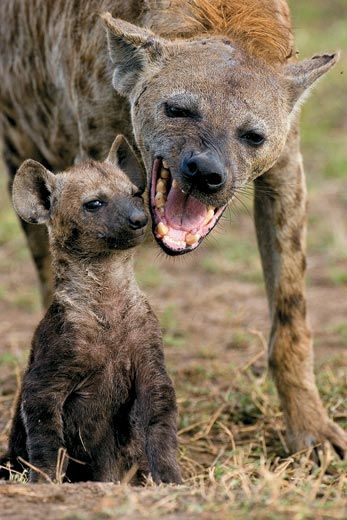
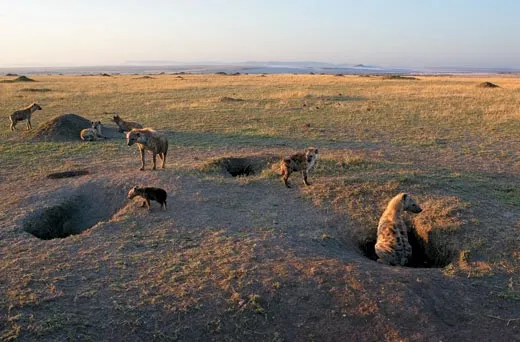
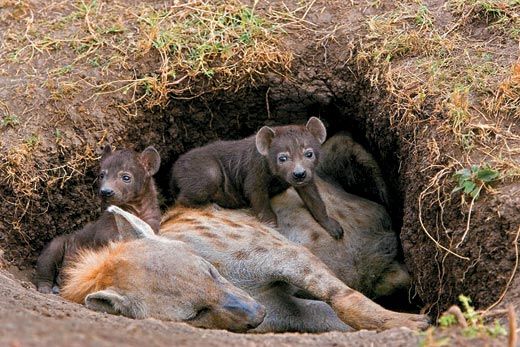
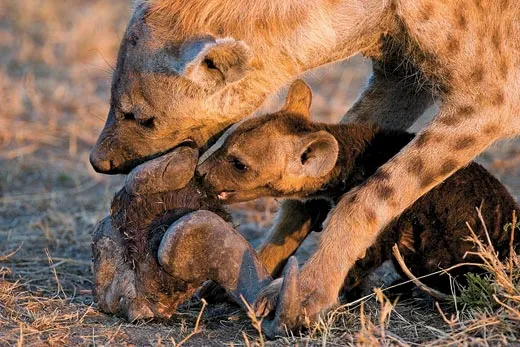
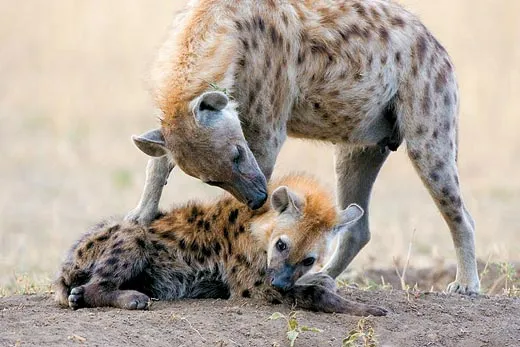
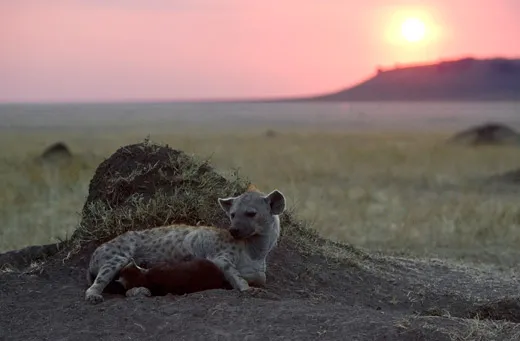
/https://tf-cmsv2-smithsonianmag-media.s3.amazonaws.com/accounts/headshot/Kemper_HighRes_2.png)